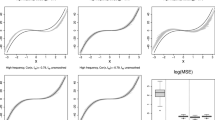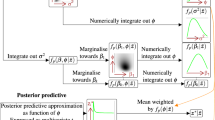Abstract
The Papadakis covariate is commonly used to account for spatial variation in agricultural field experiments. However, it is calculated from the observed yield, and is affected by unexpected land discontinuity. To address this problem, we propose two extensions. First, we introduce a kriged covariate which is based on spatial information in the field. Two covariates, namely the kriged residual and the kriged Papadakis residual, are discussed. The second extension is a modification of the conventional Papadakis covariate that assigns equal weight to neighboring plots, regardless of their distance from the point of interest. The proposed covariate (a modified Papadakis covariate) assigns different weights to plot yield according to their spatial position. The proposed extensions are compared to the conventional Papadakis covariate using field data from Ethiopia. Simulations were conducted to evaluate the performance of these covariates. The number of neighbors needed to compute the proposed covariate are determined by the range of the variogram.
Similar content being viewed by others
References
Atkinson, A. C. (1969), “The Use of Residuals as a Concomitant Variable,” Biometrika, 56, 33–41.
Bartlett, M. S. (1938), “The Approximate Recovery of Information from Field Experiments with Large Blocks,” Journal of Agricultural Science, 28, 418–427.
— (1978), “Nearest Neighbor Models in the Analysis of Field Experiments” (with discussion), Journal of the Royal Statistical Society, Series B, 40, 147–174.
Bhatti, A. U., Mulla, D. J., Koehler, F. E., and Gurmani, A. H. (1991), “Identifying and Removing Spatial Correlation from Field Experiments,” Journal of Soil Science Society of America, 55, 1523–1528.
Brownie, C., Bowman, D. T., and Burton, J. W. (1993), “Estimating Spatial Variation in Analysis of Data from Yield Trials: A Comparison of Methods,” Agronomy Journal, 85, 1244–1253.
Brownie, C., and Gumpertz, M. L. (1997), “Validity of Spatial Analyses for Large Field Trials,” Journal of Agricultural, Biological, and Environmental Statistics, 2, 1–23.
Burgess, T. M., and Webster, R. (1980), “Optimal Interpolation and Isoarithmetic Mapping of Soil Properties. I. The Semi-variogram and Punctual Kriging. II. Block Kriging,” Joural of Soil Science, 31, 315–341.
Campbell, J. B. (1978), “Spatial Variation of Sand Content and pHWithin Single Contiguous Delineations of Two Soil Mapping Units,” Soil Science Society of America Journal, 42, 460–464.
Cressie, N. (1993), Statistics for Spatial Data, New York: Wiley.
Fisher, R. A. (1926), “The Arrangement of Field Experiments,” Journal of Ministry of Agriculture, England, 33, 503–513.
— (1935), The Design of Experiments, Oxford: Oxford University Press.
Gotway, C. A., and Stroup, W. W. (1997), “A Generalized Linear Models Approach to Spatial Data Analysis and Prediction,” Journal of Agricultural, Biological, and Environmental Statistics, 2, 157–178.
Journel, A. G. (1983), “Nonparametric Estimation of Spatial Distributions,” Journal of the International Association for Mathematical Geology, 15, 445–468.
Journel, A. G., and Huijbregts, C. J. (1978), Mining Geostatitstics, London: Academic Press.
Kempton, R. A., and Howes, C.W. (1981), “The Use of Neighboring Plot Values in the Analysis of Variety Trials,” Applied Statistics, 30, 59–70.
Papadakis, J. S. (1937), “Methode Statistique Pour des Experiences Sur. Champ. Bull. Inst.,” Amel. Plantes a Salonique, No. 23.
Pearce, S. C., and Moore, C. S. (1976), “Reduction of Experimental Error in Perennial Crops Using Adjustments by Neighboring Plots,” Experimental Agriculture, 12, 267–272.
SAS Institute Inc. (1996), SAS/STAT Software:Changes and Enhancements through release 6.11. Cary, NC: SAS Press.
Wang, F., and Wall, M. M. (2003), “Incorporating Parameter Uncertainity into Prediction Intervals for Spatial Data Modeled via a Parametric Variogram,” Journal of Agricultural, Biological, and Environmental Statistics, 8, 296–309.
Wilkinson, G. N., Eckert, S. R., Hancock, T.W., and Mayo, O. (1983), “Nearest Neighbor (NN) Analysis of Field Experiments” (with discussion), Journal of the Royal Statistical Society, Series B, 45, 151–211.
Williams, R. M. (1952), “Experimental Designs for Serially Correlated Observations,” Biometrika, 39, 151–167.
Yost, R. S., Fox, R. L., and Uehara, G. (1982), “Geostatistical Analysis of Soil Chemical Properties of Large Land Areas. I. Semivariogram, II, Kriging,” Soil Science Society of America Journal, 46, 1028–1037.
Author information
Authors and Affiliations
Rights and permissions
About this article
Cite this article
Taye, G., Njuho, P. An improvement on the papadakis covariate to account for spatial variation. JABES 12, 397–413 (2007). https://doi.org/10.1198/108571107X227946
Received:
Revised:
Issue Date:
DOI: https://doi.org/10.1198/108571107X227946




